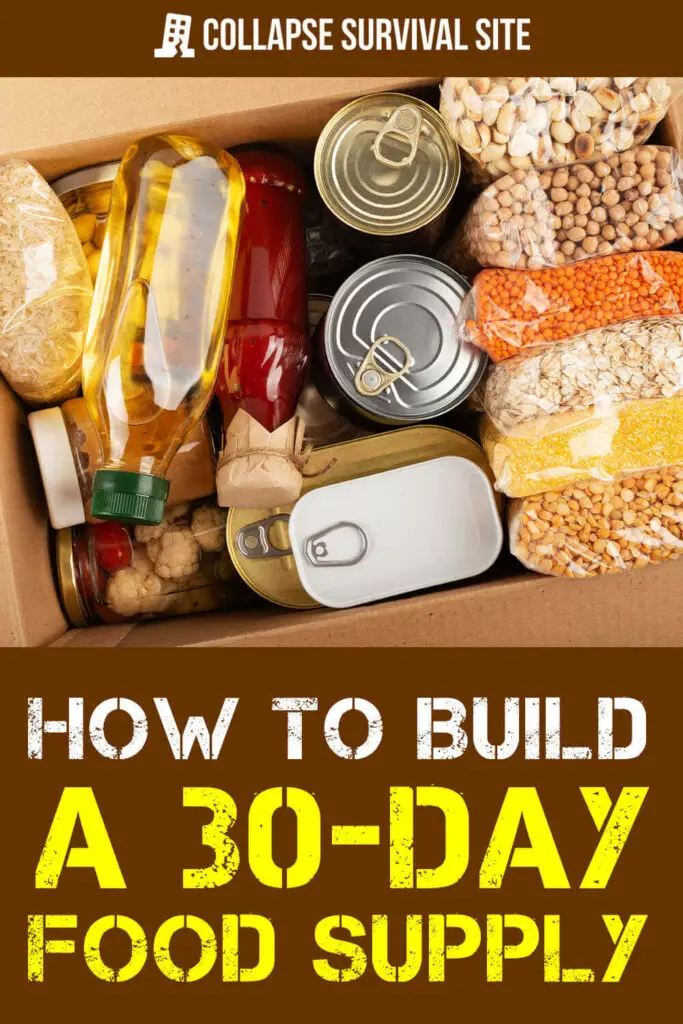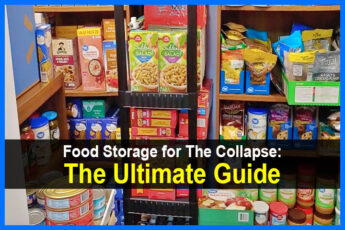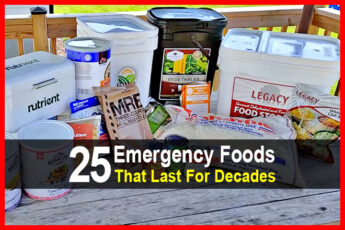Estimated reading time: 12 minutes
A common occurrence after any disaster is a breakdown in everyday services and supplies. Whether it’s a hurricane, wildfires, earthquakes, or manmade events like riots and civil unrest, stores are often closed, and simply reaching them can be difficult if not impossible.
Complicating matters is hoarding either before an imminent disaster like a forecasted hurricane, or hoarding after the event when people feel the need to buy as much as they can. The result is that common goods become unavailable, and that includes food.
In most instances, people have enough food on hand to get through at least a week. The end of the week may result in some meager and pretty grim meals, but nobody’s starving.
The good news is that most disasters don’t last much longer than that, and even during severe disasters like pandemics, essential services like grocery stores can remain open.
The real concern is related to wide-spread and long-term disasters that never seem to end. Many agencies on a local, state, and federal level are set up to provide aid and assistance to people in desperate situations, but as FEMA demonstrated during Hurricane Katrina, even the largest systems and designs can fail.
In the event of a future disaster that has long and wide effects, it’s possible that there will simply be too many people to support. At times like those, most people will be on their own until some semblance of normalcy returns.
It’s a good reason to think beyond the standard FEMA recommendation of 72-hours of survival rations and prepare for a duration of up to 30 days.
It may seem unlikely that any single event could result in such an extreme need for preparedness, but quite often multiple disasters occur at the same time. Hurricane IDA striking the gulf coast in the midst of the COVID pandemic is a good example.
Power outages were widespread in addition to flooding and an overwhelmed medical system. This was then followed by a heat wave in a broad region of more than 1 million people without electric power.
At that point, a 30-day timeframe starts to feel like a best case scenario. Lack of personal preparedness was an obvious factor as many people desperately searched for food only days after the hurricane struck.
Want to save this post for later? Click Here to Pin It On Pinterest!
Building a 30-Day Food Supply
Putting together a 30-day food supply can be done relatively inexpensively and in a short period of time. Most of us shop for groceries once a week and buy enough to make it to next week’s shopping trip.
It’s easy to assume you could just stock up for 4 weeks instead of one week and you’d be done with your 30-day food supply. And in fact, it just might be that easy.
But like so many things, there are some factors to think about if you’re in a situation where you’re on your own with few resources over 30 days.
If you’re totally dependent on stored food…
It most likely means a severe disaster has occurred. Many severe disasters result in power outages and even an outage lasting only a day could compromise any refrigerated or frozen foods. You need to think about storing foods that don’t require refrigeration or freezing to make it through the month.
Eat what you store and store what you eat
That’s the mantra of people who store food for the long-term. The easiest way to do that is to store your 30 days of food close to the kitchen.
The only challenge is that now you have to think about finding the storage space in your kitchen cupboards and pantries to keep cycling through a large stock of 4-weeks’ worth of food. Take the time to do it, unless you enjoy running up and down to the basement every day. A nearby closet is another option.
Learn to think like a grocer
Grocers constantly rotate their stock on a shelf, making sure that the oldest products are facing front and center and new deliveries are placed in the back. This keeps packaged foods ahead of the “sell-by” dates.
It’s very easy to forget about a can of stewed tomatoes month after month, and over time the acid in the tomatoes can corrode a can. In fact, all canned foods lose nutrition over time. Rotate your food as you go. Put the new stuff in the back on the shelf.
Keep an eye on nutrition
There are macronutrients and micronutrients that are very important to overall health. If you have to eat everything from bottles, cans, and boxes, you should make sure you’ve assembled a diversified collection of nutritious foods.
It may be tempting to think you could live on canned beef stew for a month (and you probably could), but the lack of nutritional diversity could eventually catch up with you, to say nothing of the monotony of eating the same thing every day.
About food in cardboard boxes
Cans are the best all-around package for everyday foods you want to store for any length time. Jarred foods in bottles are a close second, but once they’ve been opened, many require refrigeration, so be aware.
Cardboard boxes may be the worst, even with a wax or plastic-coated bag on the interior. If you’re regularly rotating and cycling through your food, there’s no problem with that box of cereal, but from a packaging standpoint, cardboard is the most prone to fail with time.
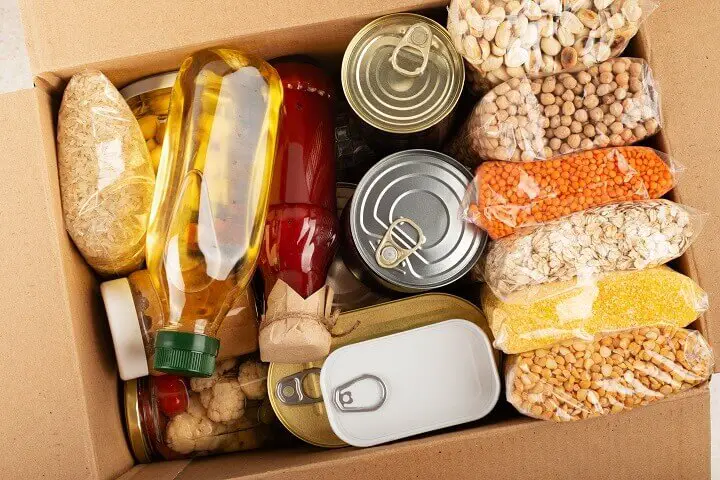
One option is to take food out of the box and out of the inside bags and store in sealed canisters, resealable containers, or large Mason jars. Moisture, insects, rodents, and temperature extremes are less likely to compromise the contents if it’s sealed tight. At least for the month or two it takes to eat it while you continue to rotate.
Shelf-Life
If you’re actually eating what you store and rotating properly, the shelf-life of most foods is not an issue if they don’t require refrigeration. If you lose track of some things and notice the “sell-by” date is expired, you may still be okay.
The FDA has indicated that many foods are still good after the “sell-by” date. How long is another question, but those dates are usually to protect the food manufacturer/processor from liability, and they usually give themselves plenty of lead time for that protection.
Proteins can be a challenge.
We derive a lot of protein from refrigerated and frozen foods. Think in terms of meats, seafood, dairy, and eggs. They all include varying degrees of complex amino acids, and some have fats like Omega-3.
It’s worth thinking like a vegan for a bit and looking at the plant sources they consume to keep their protein needs in balance. (The quick answer to the vegan dilemma is legumes or beans and peas).
You could also think about protein from canned tuna, sardines, and canned foods with meat. We’ll get into a detailed list later.
Fresh fruits and vegetables
These aren’t out of the question. Many fruits and vegetables like potatoes, avocados, apples, beets, onions and others don’t require refrigeration and, if stored properly, can last for weeks and even months. They are an excellent source of many vitamins and minerals.
Storage can be a challenge, and this may be an occasion when using the basement is a good idea. There are also alternative approaches to refrigeration. Root cellars are the traditional storage area of choice from the past, and many basements have the lower temperatures and higher humidity that allow fresh fruits and vegetables to last.
An option to fresh fruits and vegetables is to buy them dehydrated. They are packaged in #10 cans with a lid and can store for a long duration up to years and are easy to use on an everyday basis.
We’re going to use that as our option for our shopping list because pricing and quantities are easier to estimate, and some people don’t have the patience to juggle fresh onions every day.
Remember that packaged foods lose nutrition over time
From the day any food is processed and packaged, it begins to gradually lose nutritional value. It doesn’t happen rapidly and could take years, but some foods lose nutrition sooner than others, especially when you’re storing for longer durations. It’s another good reason to rotate and eat what you store.
Speaking of leftovers….
Eat any leftovers at the next meal. If you don’t have refrigeration, they can quickly become a petri dish for bacteria. Heat it up if you can and keep them covered, but eat them as soon as possible. Better yet, try to manage your portions while cooking so you have no leftovers to worry about.
Don’t forget the kids
In a desperate time when people are depending on their food storage for nutrition, it’s easy to decide to tough it out with very basic foods for survival. Kids have a harder time doing that sometimes.
Remember to buy and store kid-friendly foods whether it’s canned fruit cocktail with a cartoon character on the label or a tin of sugar cookies. It’s comfort food for kids and they might need it.
Beverages are also a comfort food
Water is critical to survival, but a 30-day diet of water can get pretty grim. Powdered drink mixes are a good change of pace. Fortified drink mixes with added vitamins or minerals are best.
Think in terms of instant lemonades and fruit drink mixes, instant coffee and creamer, tea bags and powdered iced tea mixes, cocoa powders and anything else you may have used in the past to flavor water to make a beverage.
Learn how to cook from scratch
With a few bags of flour and a jar of yeast, you can make dozens of loaves of bread. Assuming you know how to do that. It’s wise to sharpen your cooking and baking skills. It will allow you to store more food for less and give you the skills to improvise as you approach the end of those 30 days.
It also ensures a certain amount of nutritional diversity as you add and combine ingredients to make more complex dishes and meals.
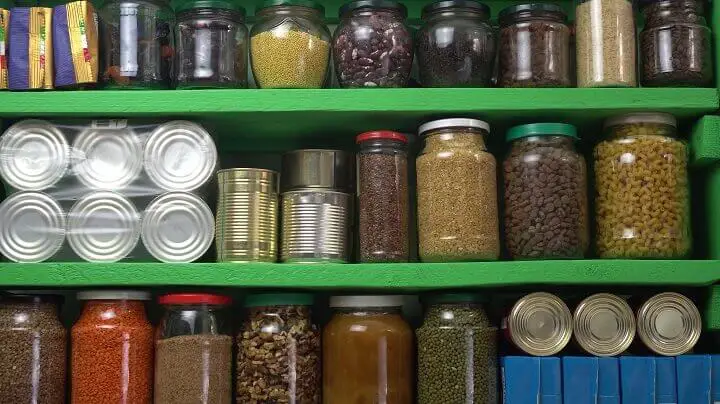
30-Day Food Checklist
Checklists are never easy to do because the needs of any individual or family always vary. This is especially true with food. Some people have certain dietary needs or restrictions. Some families have small children or even infants while others have elderly parents or relatives living with them that have specific dietary needs.
That’s why we spent a bit of time covering basic nutritional needs. The hope is that people with unique situations can make any adjustments for people with special dietary requirements.
There are also variables related to the age of people in a group, along with gender and activity levels. Those affect caloric needs above and beyond nutrients like protein, vitamins, and minerals.
With that being said, here’s a checklist that could serve as foundation for a 30-day food supply with the flexibility to adjust food types and quantities. We’ve designed this around a generic family of four consisting of an adult male and female and two children aged 10 and 13.
Using our charts and equations, that averages out to a family requirement of 10,000 calories a day or 300,000 calories for the 30 days. We’ll keep an eye on other nutritional factors as well.
We should also note that our shopping list may be well in excess of 300,000 calories total for the simple reason that it’s unrealistic to believe that every ounce of every item will be consumed in 30 days.
Nine ounces of leftover olive oil totaling 1080 calories leftover after a month is one example. Any adjustments for variations in family size, ages, or activity levels can be done using the charts and equations we outlined earlier.
While making this list, our goal was to assemble the kinds of foods and brands that you can easily buy, whether in a grocery store or online. In a perfect world, we would take our time and shop the sales at grocery stores or pursue bulk options at an outlet like Costco or Sam’s Club.
The shopping list will be organized by nutrition categories and packaging. Food quantity in ounces per package and total quantity will also be indicated.
We’ll also add some basic herbs and spices, although most people have enough on hand to get through 30 days.
One area that’s particularly challenging without refrigeration is dairy, although there are many powdered variations, with the exception of a pasteurized processed cheese spread. This is commonly known as Velveeta, and it has a proven long and stable shelf life at room temperature. Your feelings about the preservatives and the process that maintain that shelf life are up to you.
The whole list essentially assumes a kitchen of empty pantries. That’s unrealistic, and most people have some degree of food on hand. If you already have 6 cans of fruit cocktail in the cupboard, just skip them on the list. The whole idea here is to remind yourself of what you need while you take stock of what you already have.
Finally, we’ll add some basic supplements for vitamins, minerals, and some reminders about things like condiments, herbs, and spices.
30 Day Shopping List
| Nutrient Type | Food Source | Weight Per Item | Total weight or # of items |
|---|---|---|---|
| CARBOHYDRATES | |||
| Grains | All-purpose flour | 5 pounds bread flour | 15 lbs. |
| Bread Flour | 5 pounds flour | 10 lbs. | |
| Brown rice | 10-pound bag | 10 lbs. | |
| Oatmeal | 5-pound container | 2 containers | |
| Whole Wheat Pasta | 16-ounce package assorted varieties | 10 lbs. | |
| Simple Carbs | Brown sugar | 16-ounce bag | 3 lbs. |
| Honey | 8-ounce bottle | 16 ozs. | |
| Pancake syrup | 16-ounce bottle | 32 ozs. | |
| White sugar | 10-pound bag | 10 lbs. | |
| Canned Fruit | Fruit cocktail | 15 ounce can | 8 cans |
| Mandarin oranges | 15 ounce can | 16 cans | |
| Pears | 15 ounce can | 8 cans | |
| Peaches | 15 ounce can | 8 cans | |
| Pineapple | 15 ounce can | 6 cans | |
| Canned Vegetables | Beets | 15 ounce can | 4 cans |
| Black olives | 15 ounce can | 2 cans | |
| Corn | 15 ounce can | 4 cans | |
| Diced tomatoes | 15 ounce can | 12 cans | |
| Garbanzo beans | 15 ounce can | 4 cans | |
| Green beans | 15 ounce can | 8 cans | |
| Kidney beans | 15 ounce can | 4 cans | |
| Peas | 15 ounce can | 4 cans | |
| Stewed tomatoes | 15 ounce can | 16 cans | |
| Yellow beans | 15 ounce can | 4 cans | |
| Dried or Dehydrated Vegetables | Black beans | 16-ounce bag | 2 bags |
| Carrots | 2-pound 6 ounce #10 can | 1 #10 can | |
| Corn | 1 pound #10 can | 1 | |
| Onions | 1 pound 7 ounce #10 can | 1 #10 can | |
| Peas | 16-ounce bag | 2 bags | |
| Pinto beans | 16-ounce bag | 2 bags | |
| Potato flakes | 3 pound #10 can | 1 #10 can | |
| Potato slices | 1 pound 1 ounce #10 can | 1 #10 can | |
| Red and Green Bell Peppers | 20 ounce #10 can | 2 #10 cans | |
| Seaweed (Nori) | 1 ounce pack | 12 | |
| Dried or Dehydrated Fruits | Apple slices | 12 ounce #10 can | 1 #10 can |
| Banana slices | 2 pound #10 can | 1 #10 can | |
| Blueberries | 12 ounce #10 can | 1 #10 can | |
| Coconut flakes | |||
| Craisins | 20-ounce sack | sack | |
| Dates | 16-ounce container | 1 container | |
| Raisins | 12-ounce canister | 2 canisters | |
| Strawberries | 6.4 ounce #10 can | 1 #10 can | |
| PROTEIN | |||
| Seafood | Canned anchovies | 2 ounce can | 2 cans |
| Canned oysters | 3.75 ounce can | 4 cans | |
| Canned salmon | 14.75 ounce can | 4 cans | |
| Canned sardines | 8 cans | ||
| Canned tuna | 4/5 ounce can | 24 cans | |
| Seeds, Nuts, and Beans | Almonds | 16-ounce sack | 1 sack |
| Lentils | 5-pound sack | 1 sack | |
| Macadamia nuts | 8-ounce sack | 1 sack | |
| Navy beans | 16-ounce pack | 4 packs | |
| Peanut Butter | 2-pound jar | 2 jars | |
| Peanuts | 35 ounce can | 1 can | |
| Pistachio nuts | 1.5-pound pack | 1 pack | |
| Split peas | 5-pound sack | 1 sack | |
| Sunflower seeds | 32-ounce sack | 1 sack | |
| Walnuts | 16-ounce sack | 2 sacks | |
| Soups & Stews | Beef stew | 15-ounce cans | 24 cans |
| Beef vegetable soup | 18.5 ounce can | 8 cans | |
| Chicken noodle soup | 10.5 pound can | 12 cans | |
| Chili with beans | 15-ounce cans | 8 cans | |
| Corned beef hash | 14 ounce can | 8 cans | |
| Spaghetti sauce with meat | 24-ounce jar | 12 cans | |
| TVP | Beef meat substitute | 2-pound 5 ounce #10 can | 1 #10 can |
| DAIRY | |||
| Butter powder | 1 pound butter powder jar | 1 jar | |
| Cheese powder | 3-pound 4 ounce #10 can | 1 #10 can | |
| Dry milk | 3-pound 8 ounce #10 can | 1 #10 can | |
| Powdered eggs | 2-pound 4 ounce #10 can | 1 #10 can | |
| Protein powder chocolate drink mix | 2-pound container | 1 container | |
| Velveeta | 2-pound block | 4 blocks | |
| FATS | |||
| Oils | Olive oil | 101-ounce tin | 1 tin |
| Safflower seed oil | 32-ounce bottle | 1 bottle | |
| Sunflower seed oil | 33-ounce (1 liter) bottle | 1 bottle | |
| Any product canned in oil | various | ||
| BEVERAGES | |||
| Powdered Mixes | Coffee creamer | 16-ounce jar | 1 jar |
| Iced tea mix | 100-ounce canister | 1 canister | |
| Instant coffee | 16-ounce jar | 1 jar | |
| Lemonade mix | 5-pound canister | 1 canister | |
| Tea Bags | Black tea | 100 bags | |
| Chamomile tea | 24 bags | ||
| Green tea | 100 bags | ||
| HERBS & SPICES | |||
| Baking powder | 8 ozs. | ||
| Baking soda | 12 ozs. | ||
| Black pepper | 4 ozs. | ||
| Cayenne pepper | 2 ozs. | ||
| Chicken bouillon cubes | 30 cubes per package | 60 cubes | |
| Chili powder | 4 ozs. | ||
| Chives | 4 ozs. | ||
| Cinnamon | 6 ozs. | ||
| Corn starch | 16 ozs. | ||
| Instant gravy mixes: beef and chicken | 1-ounce packets | Total of 12 packets of each | |
| Iodized salt | 4 pounds | ||
| Italian herbs | 4 ozs. | ||
| Seasoned salt | 16 ozs. | ||
| Yeast | 2¼ ounce packet | 30 packets | |
| CONDIMENTS | |||
| Apple cider vinegar | 2 gallons | ||
| Dijon mustard | 12 ozs. | ||
| Hot sauce | 4 ozs. | ||
| Ketchup | 32 ozs. | ||
| Soy sauce | 12 ozs. | ||
| White vinegar | 1 gallon | ||
| Yellow Mustard | 20 ozs. | ||
| SUPPLEMENTS | |||
| Children's multivitamin and mineral supplement | 150 tablets per bottle | 1 bottle | |
| Electrolyte drink mix | 35-ounce package | ||
| Multivitamin / multimineral supplement | 200 tablets per bottle | 1 bottle | |
It’s possible that some may look at this list and feel that it’s incomplete. Others will think it’s an over-reaction. All of that gets back to the different perceptions and ideas that people have about most things, including food.
If anything, think of it as a thought starter for what you may or may not need in order to provide balanced nutrition for your family in a time of disaster.
Conclusions
Disasters are increasing. Reports of natural disasters are on the rise due to a growing population density and the emerging effects of climate change. Civil unrest and civil war is an on-going fact of life around the world.
In the grand scheme of things, putting together some additional food to last 30 days is not terribly difficult. Even if it’s a slow process over a period of months, the behaviors related to rotating a larger home inventory of stored foods can allow someone to cost-effectively increase their available supply of food.
It all gets down to making the simple decision to start the process and stick with it.
Like this post? Don't Forget to Pin It On Pinterest!

